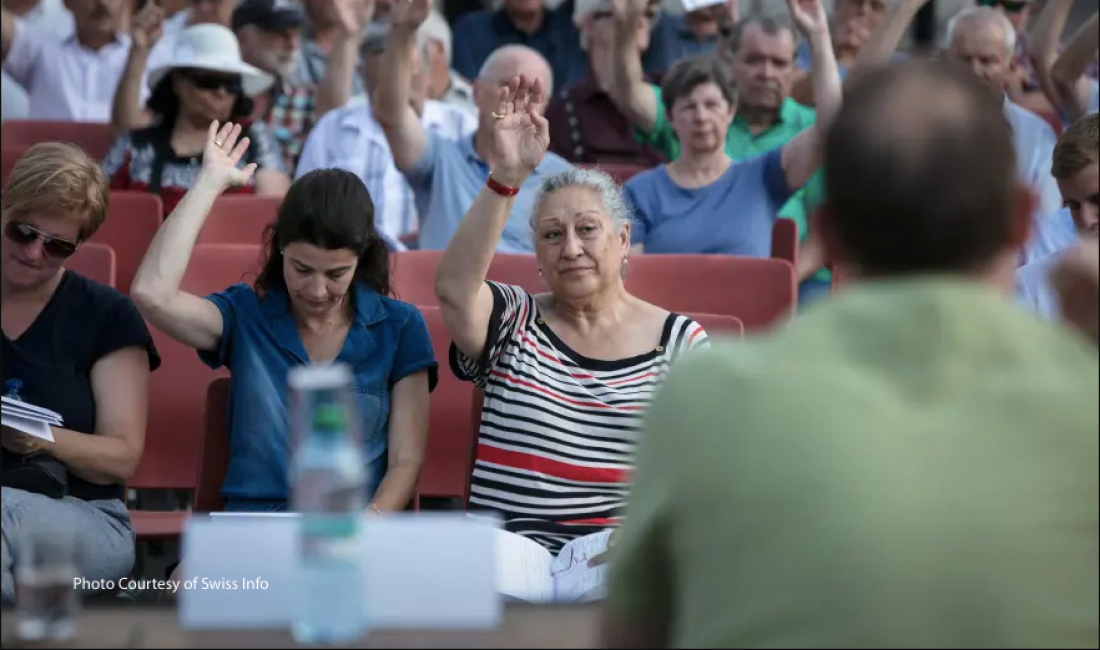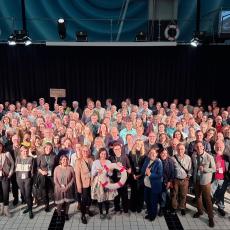The Lessons of Swiss Municipal Assemblies
This story was produced and published by Swiss Info.
In many Swiss municipalities, voters gather in local assemblies to decide on community matters themselves instead of leaving them to parliaments of elected officials.
How does the system work?
Coming together to decide on political issues that affect your daily life – that sounds about as close to direct democracy as it gets.
“Assembly democracy is generally regarded as not only the oldest, but also the most directly democratic way to organise a community,” says political scientist Philippe Rochat.
The underlying idea is that citizens meet one another as equals.
Almost half of the voters in Switzerland can experience this hands-on form of direct democracy because they live in one of the more than 1,650 municipalities where an assembly of citizens takes decisions instead of an elected local parliament.
Assembly Democracy in Villages and Towns
From small villages of only a few dozen people to the town of Rapperswil-Jona with nearly 30,000 residents, Swiss communities put their faith in this system of assembly democracy.
In many municipalities, invitations to the assembly are dropped into voters’ letterboxes twice a year, along with the agenda and the municipal budget.
At the meeting, citizens gather in a community hall or school gymnasium to discuss issues and take decisions by raising their hands – or, if they wish, by secret ballot.
Customs differ from place to place. In Horgen, a town in canton Zurich of 22,000 people, residents vote by standing up.
“In Horgen, people stand by their opinions,” a former mayor once said.
Town Meetings in the US and Municipal Assemblies in Germany
Like the cantonal Landsgemeinde in Glarus, which was recently reported on by National Geographic magazine, the municipal assembly fascinates outsiders as a hallmark of Swiss democracy. Yet it is not unique. Elsewhere too, citizens take democratic decisions face-to-face in public gatherings.
Political scientist Michael Strebel notes that municipal assemblies were also widespread in Germany. The German post-war constitution authorised them as an alternative to the local parliaments.
Around 25 small villages in the German state of Schleswig-Holstein still practise a form of these assemblies today.
Strebel also draws parallels with town meetings in parts of the US.
“In some US municipalities these assemblies of citizens allow voters to decide on various aspects of local policy – and in some cases their decisions are legally binding,” he explains.
Where Democracy is Built On a Handshake
“What can the rest of the country learn from this?”
Asked the headline of a 2024 Associated Press report on a town meeting in Vermont. People tell each other what they think, but there is no animosity. They shake hands with their neighbours when they leave.
Similarly, many in Switzerland see the municipal assembly as an instrument of exchange and compromise. It is a place where citizens can challenge their local political representatives face-to-face, and where political opponents come together to talk.
“In my experience, what people really value is the opportunity for direct participation, rooted in long-standing tradition,” says Strebel.
“These assemblies have clear powers and responsibilities, which means their decisions carry real weight,” he adds.
Still Popular in German-speaking Switzerland
“For voters, the municipal assembly is a chance to give in-person feedback on local policy. It is seen as a way to get directly involved,” says Strebel, who not only attends assemblies as a researcher, but also as a voter in the cantonal capital of Solothurn, where he lives.
Philippe Rochat emphasises another advantage of the municipal assembly: the space for deliberation. Unlike a ballot box, it allows people to speak out – not just with clear opinions, but also with doubts. The key, he says, is a “culture in which differing views can be voiced without fear of consequences.”
In cantons Geneva and Neuchâtel a local parliament is mandatory, but in German-speaking Switzerland, the municipal assembly is widespread and remains popular. In recent years, most votes on introducing a local parliament in these places have failed.
Participation is Low, But Decisions are Accepted
It seems that more people appreciate the institution of the municipal assembly than those who actually attend it.
Ten years ago, in some large municipalities, only 0.8% of those entitled to vote took part in assemblies – while in smaller, close-knit municipalities, participation reached almost 45%.
In 2016, the late political scientist Andreas Ladner estimated that, across Switzerland, some 300,000 people attend a municipal assembly every year. No reliable, up-to-date statistics exist today, but Strebel’s analysis shows that the percentage of participation has been in the single digits.
“These were the municipalities that were discussing a change to a parliamentary system,” he says.
“The municipal assembly is seen as the place of political decision-making, as a centre of direct democracy, regardless of how many people actually attend,” Strebel says.
But the low participation rate does not affect the institution’s legitimacy or its acceptance. According to Rochat, municipal assemblies’ decisions are usually broadly accepted, despite low participation.
Democratic Deficit, Citizenship Applications and How Football Clubs Get a New Pitch
Opponents criticise the low participation rate of municipal assemblies, arguing that it allows a minority to decide on the interests of everyone. They also argue that the local authorities can tip the balance in their favour by mobilising support at the gathering.
Notably, voters in many places also decide on citizenship applications at the assembly. This has repeatedly caused a stir and led to accusations of racism and arbitrariness when citizenship is rejected, for example, because the person mowed the lawn on Sundays or wore tracksuit bottoms in public.
Municipal assemblies also make headlines when clubs or interest groups exploit the low turnout. When a group gathers its members at a particular meeting, it allows them to succeed in winning local funds for their own interests. One example was the approval of an expensive new football pitch with artificial turf.
This is “a well-known phenomenon”, Strebel says. He has also seen how people on one side of an issue use forceful campaigning to push through their demands”.
How common this is overall, however, is unknown.
To counter this kind of skewed participation, Strebel suggests that municipal assembly decisions be subsequently confirmed at the ballot box. Some municipalities already have such rules and require a referendum once spending surpasses a certain threshold.
Rochat’s research also points to a different pattern. In many assemblies he observed, there was a “morality of the common good”, in which participants, especially in large municipalities, acted on behalf of those who were absent.
As a result, votes were often cast not just out of self-interest, but with a sense of responsibility.
Edited by Marc Leutenegger, Adapted from German by David Kelso Kaufher/ds



